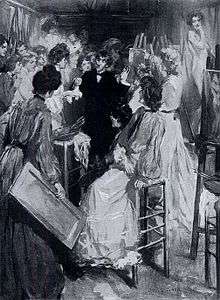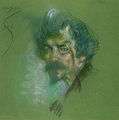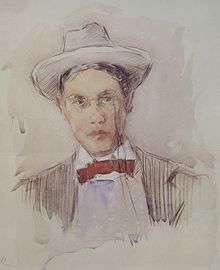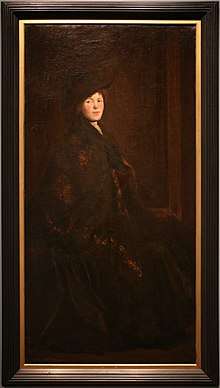Académie Carmen
Académie Carmen, also known as Whistler’s School,[1] was a short-lived Parisian art school founded by James MacNeill Whistler. It operated from 1898 to 1901.

History
The school opened in October 1898 in a large house and stable at No. 6 Passage Stanislas, near the Rue Notre Dame du Champs.[2] The business side of the school was handled by Whistler's former model Carmen Rossi, for whom the school was named, and her musician husband.[3] The number of students was limited to forty, most of whom were women.[2] More than half of them were American, "with several also coming from England, Ireland, and Scotland."[4] Instructors for the first year were Whistler (painting) and American sculptor Frederick William MacMonnies (life drawing).[5] Whistler taught without pay as a "visiting professor," and appeared once a week to offer criticism.[6]
Initially, all the students met in a single class.[2] Whistler made his first appearance at the beginning of the second week, and, at his insistence, the students were separated into women's and men's classes.[2] Experienced students were appointed teaching assistants. The women's class was led by Irish painter Inez Eleanor Bate for the length of the school's tenure.[7] The men's class was led by a series of assistants—American painter Earl Stetson Crawford,[8] Czech painter Alphonse Mucha,[9] Italian painter Cyrus Cuneo, and lastly, American painter Clifford Addams.[6] With a dearth of sculpture students, MacMonnies left after the first year.[2]
In a 1906 magazine article, Cuneo described Whistler's eccentricities, his inability to communicate effectively as a teacher, and his strong favoritism toward the women's class:[3] "Instead of sitting down in the usual French fashion and giving each pupil in turn a clear and matter-of-fact criticism, Whistler airily picked his way amongst the easels, glancing here and there, ignoring some canvases altogether, greeting others with 'Yes—yes.' "[3] "Whistler's methods and manner confused the average students who came, but his faith in his system was as great as the students' unbelief."[2] Despite the prestige of his fame and reputation, many of the students dropped out.[2] The frustration of the male students was expressed in a poem Whistler found scrawled on a wall of the men's studio:
I bought a palette just like his,
His colours and his brush.
The devil of it is, you see,
I did not buy his touch.[2]
The frustration turned to resentment in the second year. Whistler's apprentice Inez Eleanor Bate recalled: "[A]t the latter part of the season he often refused to criticize in the men's class at all. He would call sometimes on Sunday mornings [when the school was empty], and take out and place upon easels the various studies that had been done by the men the previous week, and often he would declare that nothing interested him among them and that he should not criticize that week, that he could not face the 'blankness' of the atelier."[2] By the third year, the men's life class was cancelled due to lack of students.[2]
Whistler was not always in good health, which may have accounted for many of his absences. His doctors recommended convalescence in a warmer climate, and he sent New Year's greetings for 1901 to the students from Corsica.[2] The school continued to struggle, and descended into quarrels and mistrust.[3] "In the end, the want of confidence in him, his illness, and his absence broke up the school."[2] Whistler announced its closing in a letter sent from Corsica, and read aloud to the students on April 6, 1901.[6]
Whistler's hopes of establishing an art school in London under the management of apprentices Inez Eleanor Bate and Clifford Addams, who married in 1900, were defeated by his continued poor health.[2] He died in London on July 17, 1903, at age 69.
Students
.jpg)
- Lucien Abrams

- Clifford Addams (tutor)

- Alice Pike Barney

- Frederic Clay Bartlett

- Inez Eleanor Bate (tutor)

- Carlotta Blaurock

- Simon Bussy

- Blendon Reed Campbell

- Alson S. Clark

- Earl Stetson Crawford (tutor)

- Cyrus Cuneo (tutor)

- Edward Dufner

- Mary Foote

- Frederick Carl Frieseke

- Louise Elizabeth Garden MacLeod

- Lillian Genth

- Mary Hughitt Halliday

- Paul Henry

- Ilka Howells

- Henry Salem Hubbell

- Louise Williams Jackson

- John Christen Johansen

- Gwen John
.svg.png)
- Lydia Longacre

- Will Hicok Low

- Alphonse Mucha (tutor)

- Mary Augusta Mullikin

- Ida Nettleship

- Anna Ostroumova-Lebedeva

- Lawton S. Parker

- Ambrose McCarthy Patterson
.svg.png)
- Hugh Ramsay
.svg.png)
- Gwen Salmond

- William Otis Swett

- Nell Marion Tenison

- Eugene Paul Ullman

- Mary van der Veer

- Hans Albrecht von Harrach

- Marie von Rietgenstein

- Emmi Walther

- Charles Henry White
.svg.png)
- Alice Woods

 La Napolitana – Carmen Rossi (c.1897) by James Whistler
La Napolitana – Carmen Rossi (c.1897) by James Whistler James Whistler (1898) by Alice Pike Barney
James Whistler (1898) by Alice Pike Barney Japanese Girl with Doll (c.1898-1901) by Mary Foote
Japanese Girl with Doll (c.1898-1901) by Mary Foote Self-Portrait (1899) by Alphonse Mucha
Self-Portrait (1899) by Alphonse Mucha.jpg) Self-Portrait (c.1900) by Gwen John
Self-Portrait (c.1900) by Gwen John Nude (c.1900) by Hugh Ramsay
Nude (c.1900) by Hugh Ramsay Self-Portrait (1901) by Frederick Carl Frieseke
Self-Portrait (1901) by Frederick Carl Frieseke Madame Fisher (c.1904) by Eugene Paul Ullman
Madame Fisher (c.1904) by Eugene Paul Ullman
References
- Reynolds, Siân (June 2000). "Running away to paris: expatriate women artists of the 1900 generation, from Scotland and points south". Women's History Review. 9 (2): 327–344. doi:10.1080/09612020000200249. ISSN 0961-2025.
- Elizabeth R. & Joseph Pennell, "The Académie Carmen," in The Life of James MacNeill Whistler (Philadelphia: J. B. Lippincott Company, 1911), pp. 373-88.
- Cyrus Cuneo, "Whistler's Academy of Painting, Some Parisian Recollections," The Pall Mall Magazine, vol. 38, no. 163 (November 1906), pp. 531-40.
- Mary Augusta Mullikin, "Whister's Teachings," The Boston Evening Transcript, March 17, 1904.
- Frederic William MacMonnies, from The Correspondence of James MacNeill Whistler.
- Robyn Asleson, "The Idol and His Apprentices: Whistler and the Académie Carmen of Paris," in Linda Merrill, et al., After Whistler: The Artist and His Influence on American Painting (Atlanta, GA: High Museum of Art, 2003), pp. 74-84.
- Inez Eleanor Addams, from The Correspondence of James MacNeill Whistler.
- Earl Stetson Crawford, from The Correspondence of James MacNeill Whistler.
- Alphonse Mucha: Master of Art Nouveau, exhibition catalogue, (Glen Falls, NY: The Hyde Collection, January 2018).
- William Leonard, John; Marquis, Albert Nelson (1914). Who's Who in America, Volume 8. A.N. Marquis. p. 869.
| Wikimedia Commons has media related to Académie Carmen. |